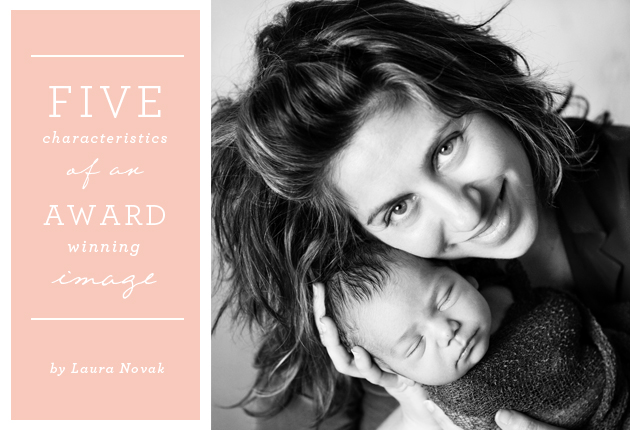
23 Jan Five Characteristics of an Award Winning Image!

Presenting work to the scrutiny of others is an accomplishment in and of itself, so I congratulate every entry in this year’s NAPCP Image Competition. To submit images that, by definition, are so uniquely personal can often be nerve-wracking; I don’t envy the butterflies some of you must be experiencing as you await our ruling! But the undeniable talent and skill represented in this year’s applicant pool is enough to tame those butterflies; learning and competing alongside such professionals can only encourage growth in your own work!
Many of us aim to capture natural, spontaneous moments through beautiful portraiture. My personal aesthetic, which is reflected in my own photography, leans towards the clean, relationship-focused image; but we all know that achieving that winning image is not always as simple as is sounds!
After critiquing the work of my staff, I went back and thought a bit about what I tend to prefer in imagery. The following criteria seem to jump out at me as areas that I think contribute to a winning image.
1) Strong Lighting – There isn’t a secret formula here. You all have fellow photographers you admire – those whose work you seek to emulate; and certainly those photographers have their own styles and preferences in lighting. So, when I speak of strong lighting, I certainly don’t mean that every contest winning image must be one in which the subject is backlit or one that utilizes natural light as my studios do. I simply mean that the lighting you employ in your image must act in cooperation with the subject and with the story you wish to tell. We wouldn’t expect to enjoy an image of a smiley, roly-poly two-year-old, shot in an editorial style with high-fashion lighting any more than we would expect to enjoy listening to the soundtrack of Indiana Jones during a family wedding. The key here is consistency; aim for appropriate lighting that highlights your subject instead of distracting from her.
While the specific type of appropriate lighting might change from subject to subject and from setting to setting, catch lights are a bit more straightforward. For strong images I look for a single catch light, usually in the upper portion of the eye. I find that a single catch light communicates emotion and depth, where multiple catch lights can distract the viewer and hide a child’s eyes. We are all drawn to that certain sparkle that each child has; perhaps only photographers will be able to identify that a catch light contributes to that draw, but I can guarantee that everyone will appreciate the impact that draw creates.

2) Clear Composition – A good image conveys emotion and compels the audience to recognize that emotion within the first second of viewing. Composition is one of the first tools you can utilize to begin story-telling.
When creating composition in an image, don’t be afraid to include background, but that background should always contribute to the story you are trying to tell and not take away from the subject. Part of the pull in your image will be your subject(s) connection with his or her surroundings, but never let those surroundings overpower your main focus.
Crop also plays a role in the draw your image has on your audience. One mistake I often notice in beginning photographers is that they often fail to get in close enough to their subject, trying to include too much information in the frame. By moving around your focal point, you can be sure that the composition of your images echoes the narrative you wish to communicate, rather than working against it.

3) Story – Ever heard that over-used cliché: “A picture speaks a thousand words”? Well it might be time to sit a bit with your images and start brainstorming: What are a few of those words your image speaks? You might even think about writing down a few if this helps you (don’t worry – I won’t hold you to the thousand word mark)!
The overarching common denominator, the common thread that I’ve found in successful images is story-telling: a big picture. Relationships and expression contribute to a strong story; and, while a stellar image might be simple, the story behind it is anything but.

4) Relationships – Open your favorite book, or better yet, a favorite book from your childhood. Who or what do you read about first?
It’s the people and places that keep us interested right? And it is the relationships that keep us reading. Whether you have a single subject, and the interaction is strictly between the subject and you, the photographer, or whether you have an entire family to capture, you can’t tell a compelling story without defining relationships. Strong images illustrate the bonds between subjects; they give us glimpses into the everyday play routine of two sisters or the silly love between father and son. You can’t go wrong by getting to know your subjects and connecting with them; chances are, what motivates them might just help you create an image that everyone will cherish.

5) Powerful Expression – Interesting expression is crucial for strong photography. Lighting and catch lights obviously play key roles in communicating a subject’s expression; but capturing expression has a little something to do with your connection to your subject and everything to do with your photographer instincts and timing. I’ve often looked at an image (maybe you recall a similar time) where I can identify that that winning moment happened one shot earlier or perhaps that it might have happened in the next frame. You all know that as photographers, we deal in seconds and moments; and you are all talented professionals who produce beautiful, moving work. The difference is in the details; it is in timing your shutter down to the exact, right second that makes the distinction between a moving image and a dazzling one.
Thank you to everyone who has submitted images for this year’s contest; to judge the work of such talented photographers really is a great privilege. I hope some of these ideas spark your creativity! – Laura




No Comments